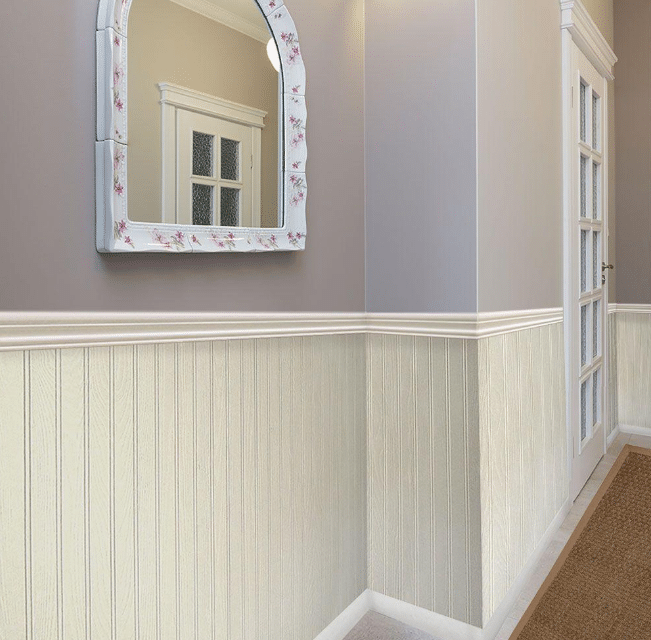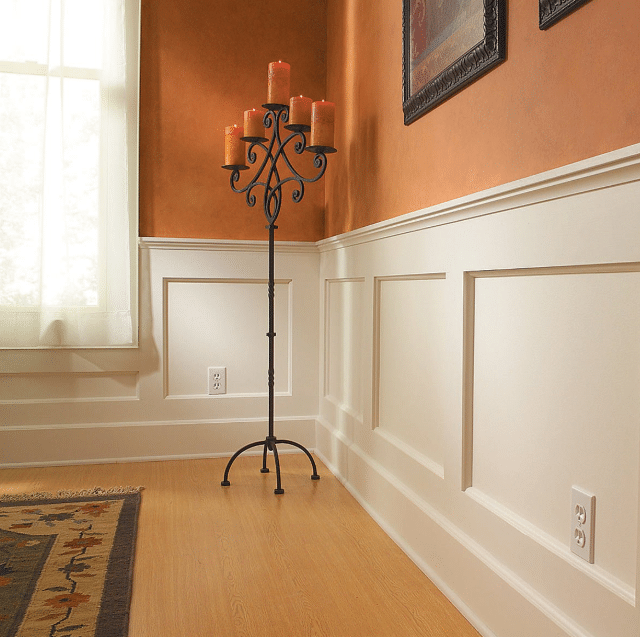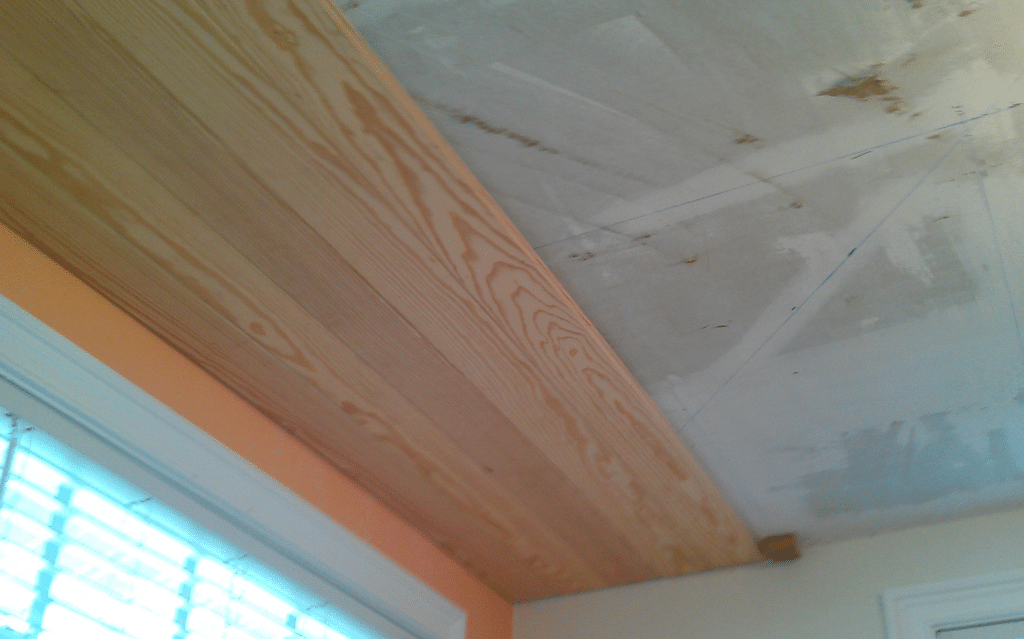Wainscoting: Wainscot, interior paneling in general and, more specifically, paneling that covers only the lower portion of an interior wall or partition. It has a decorative or protective function and is usually of wood, although tile and marble have at times been popular. The molding along the upper edge is called a wainscot cap and may serve as a chair rail.
Raised panels, the most traditional wainscoting style, go back to colonial days. The decorative raise is created by beveling the edges of the panel. Common height is between 30 and 40 inches, but the design can be adapted for higher-ceilinged spaces by adding a center rail to create two rows of panels. The rails, stiles, and panels fit together the same way as in traditional flat-panel assemblies. The bottom rail can double as the baseboard, as it does here, or the baseboard can be built up from several pieces of molding.

A typical use of wainscot appears in early English Renaissance mansions where oak paneling to a height of 8 or 10 feet (2.5 to 3 m) was installed and hung with paintings or armor. The French equivalent for wainscot is boiserie. The latter term’s use is generally reserved. However, for the profusely decorated paneling, often carved in low relief, of the 17th and 18th centuries in France.
Wainscoting Ideas
There are three main types of wainscoting. Firstly, there is beadboard, which is the most basic type and consists of simple wooden panels with vertically routered lines and a baseboard beneath the chair rail, providing an elegant country charm.
The second type is shadow boxes, which use ogee molding to create a series of frames on the face of the wall, adding new dimension and depth to the room.
The third type is panel molding in which rails and raised panels are used to create classic recessed boxes along the lower part of the wall.
Wainscoting Panels
Paneling was developed in antiquity to make rooms in stone buildings more comfortable.[citation needed] The panels served to insulate the room from the cold stone. In more modern buildings, such paneling is often installed for decorative purposes. Paneling, such as wainscoting and boiserie in particular, may be extremely ornate and is particularly associated with seventeenth and eighteenth-century interior design, Victorian architecture in Britain, and its international contemporaries.
Wainscoting Bathroom
They’re both alternatives to tiles and they’re commonly mentioned when talking about bathrooms. Wainscoting is a kind of wood paneling that can serve various different purposes. It can be used as a decorative element, as insulation or to prevent or cover up water damage on walls. It can be installed at any height.
Wainscoting is installing wooden trim and panels in a pattern along the wall. It is topped off with a horizontal strip of molding that spans the circumference of a room. We’ve already shared such ideas a couple of years ago, and as this kind of decor is on and gaining popularity now I’d like to go back to the topic and have a look at wainscoting in particular: in bathrooms.
Beadboard is a very popular decorative technique that is used in many bathroom designs. Beadboard in bathroom redecorating involves installing a series of panels that are called planks. These planks are usually placed on the wall in a vertical position and provide a uniform look. Although, in some cases, it can be installed horizontally.
White Beadboard Bathroom
Transitioning a bathroom from its old look to a brand new updated style can really be a pleasurable experience. Homeowners have lots of choices when selecting beadboard for bathroom walls. This type of choice is good because most people want to make sure the remodel is done right so that it will last many years. The fact is that this type of bathroom makeover can truly add a lot of value to the home. Should the home be up for sale in the future, a great looking bathroom is definitely a major selling point with homebuyers.
DIY Wainscoting
Plan the Layout
To make this DIY project easy, use hardwood plywood along with pre-squared, pre-planed, dimensioned hardwood lumber, or S4S (“surfaced on four sides”) which can be found at better home centers. By using readily available stock lumber sizes, such as the 1×4 and 1×6, this project becomes more of a simple assembly job and less of a custom-cutting and fitting chore.

Mark Stud Locations
It is to nail the vertical stiles to a stud so they’ll be firmly anchored. However, because all of the stiles will be connected to the top and bottom rails, which span multiple studs and are well anchored, this is not required. In your layout, try to avoid placing any of the stiles over an electrical outlet.
Install the Plywood Panels
Measure up from the floor to the height you want your wainscot (ours is 35 inches), then use a level (or ideally, a laser lever) to extend this mark across the length of the wall. This line marks the top of the paneling and upper rail. The measurement includes a 1/4-inch gap at the bottom to allow for any variations in floor height.
Beadboard Wainscoting
Choose from any of our packaged, pre-cut kits that contain everything you need or individual Beadboard Planks or custom made Sheets. Our beadboard wainscoting kits let you turn back the clock in the best possible sense of the phrase. BeadBoard is a traditional architectural feature that includes delicate, vertical grooves “beads” milled into the wood.
Beadboard can be used as stand-alone wall paneling or surrounded by stiles and rails as part of a wainscoting installation. Either way, beads are key. They conceal joints and any slight mismatch between neighboring panels. They also provide just enough visual interest to attract the eye. Closely spaced beading looks best in shorter installations, wider bead spacing for tall ones.
What Is Wainscoting For?
Wainscoting is a broader term referring to decorative paneling used for centuries as a) a wall accent; b) insulation and; c) to prevent (and cover-up) damage to walls. It typically is made of wood and covers the lower three or four feet of an interior wall.
What Are The Different Types Of Wainscoting?
There are five main types of wainscoting panels: Raised Panel, Flat Panel, Beadboard, Overlay, and Board and Batten. Raised panel wainscoting is distinguished by the panels being in front of the styles and rails. The result is that the panels look as if they are raised.
Is Wainscoting Expensive?
The price of wainscoting ranges from $7 to $40 per square foot, depending on the type of panel. Installation costs average $90 per hour or about $5.50 per square foot (including materials and labor). The biggest impact on your budget is the size of the space: a 12- by 12-foot room requires over 15 hours work.
How Tall Should Wainscoting Be?
A good general rule for the height of a wainscot is that it be a third of the way up the wall. In a room that’s nine feet tall, for example, this would put the height of the wainscoting at three feet.



![How to Turn Your Memories into Canvas [Style Guide]](https://homeimprovementall.com/wp-content/uploads/2021/11/image-2.jpg)